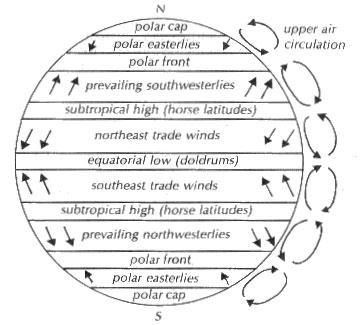Question: Which are the three main factors that influence atmospheric pressure?
Answer: The main factors that influence air pressure are:
- Altitude: Air pressure is highest at mean sea level and decreases with increasing height. This happens because the atmosphere becomes thinner (less dense), in the upper atmospheric layers.
- Air temperature: Air pressure is also affected by the temperature of the atmosphere. Cold air exerts greater pressure as it is heavier than hot air.
- Moisture content: Air laden with moisture is lighter, and therefore exerts less pressure, than dry air.
Question: Name and explain the four pressure belts of the world with a help of suitable diagram.
Answer: The four major, permanent pressure belts of the world are:
The equatorial low pressure belt or the ITCZ (0° to 5° N and 0° to 5°S):
- This belt of low pressure extends from around 5° N to 5°S latitude. In the equatorial region, the rays of Sun fall vertically on the Earth’s surface, therefore the level of insolation is high.
- The air gets heated and rises, leading to the creation of low pressure. This zone is also known as the doldrums as little or no surface wind blows in this region.
- This low pressure zone is also referred to as the inter-tropical convergence zone (ITCZ), as air converges here from surrounding areas, drawn by the low pressure.
- The air is then carried up by powerful convection currents that cause severe thunderstorms in this region. Places in this zone receive precipitation over 200 days of the year.
The sub-tropical high pressure belt (30° N to 35° N and 30° S to 35° S):
- This belts extend along the Tropics of Cancer and Capricorn, around 30° N and S latitudes.
- Air rises above the equator, and when it reaches the troposphere, it starts flowing towards the poles.
- This air starts converging (or coming together) between 25° and 35° N and S latitudes. The air also loses heat through radiation.
- Upper air convergence and cooling, together, causes the air to subside over the sub-tropics. This descending air creates the sub-tropical high pressure belts.
The sub-polar low pressure belt (60° N to 65° N and 60° S to 65° S):
- The sub-polar low pressure belts occur around 60° N and S.
- This is a zone where two wind systems converge-the Prevailing Westerlies and the Polar Easterlies.
- The Westerlies being warmer, is forced to rise over the cold polar air. This rising air creates this area of low pressure. This is a zone of storms caused by the powerful uplift of air.
The polar high pressure belt (85° N to 90° N and 85° S to 90° S):
- The polar high pressure belts are found over the north and south poles.
- In these regions the solar energy intercepted by the surface of the Earth is very low, leading to low terrestrial radiation.
- The air over the poles is therefore always cold, dense and heavy, thereby creating belts of high pressure.
 Class Notes NCERT Solutions for CBSE Students
Class Notes NCERT Solutions for CBSE Students



